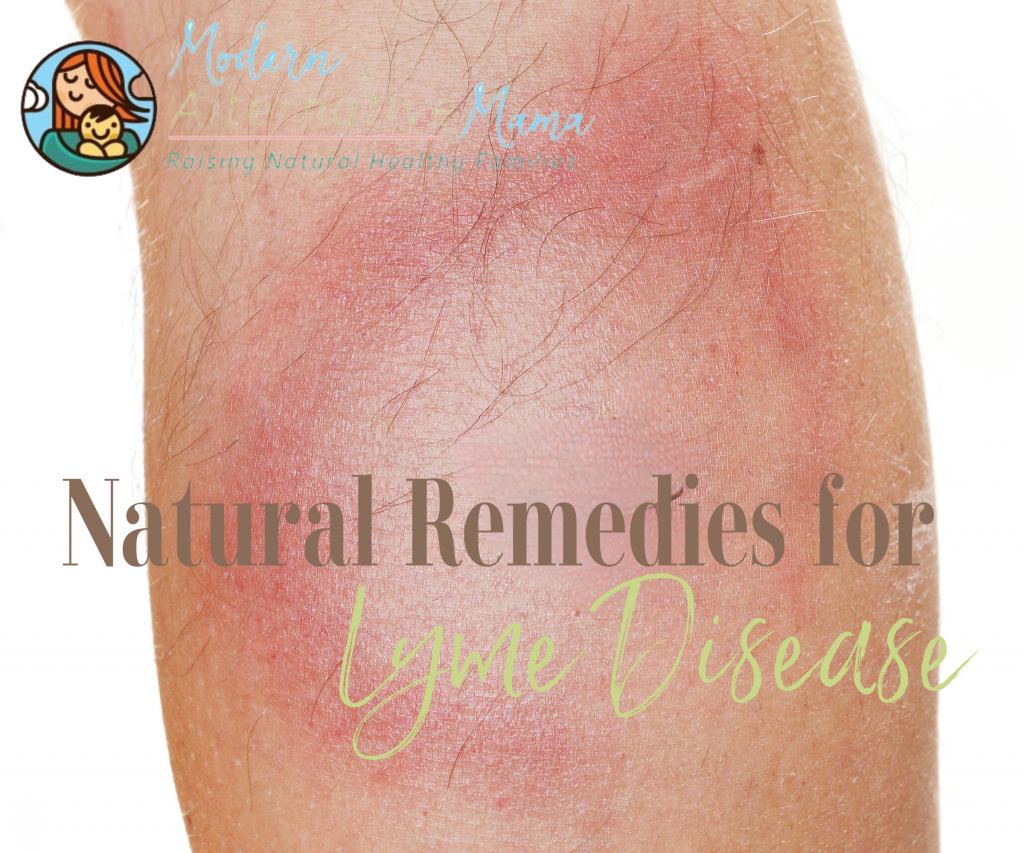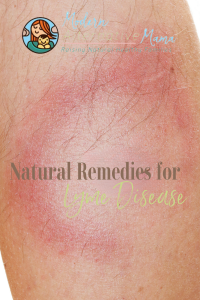By Rustina, Contributing Writer
Seeing a bullseye rash on my 6 year old was terrifying. I had heard a lot about Lyme (I thought), but this was the first time I had encountered it. Of course, it was during early spring of 2020 so getting help wasn’t going to be easy either!
We never saw the tick, or whatever insect that bit him, so testing wasn’t possible. He did have what looked like a spider bite on his chest about 3 inches from where the first (of many) bullseye rashes occurred.
I know how hard it was to make decisions about what to give him for support, I want to share what I learned and how we handled it.
How to Recognize Lyme Disease (symptoms)
While testing is not always accurate, here are some symptoms for the different stages of Lyme disease (1).
Early signs (2):
- Erythema migrans – the classic Lyme red bullseye rash. The very center usually has a red spot, then normal looking skin, and then the red outer ring. This generally appears within a few days of the bite. A rash will not always be present with Lyme. If this rash is present, then it is certainly Lyme. Multiple bullseye rashes can occur throughout the whole body. Interesting note: these can expand up to 12 inches wide!
- Flu-like symptoms: fever, fatigue, and body aches
- Headache
- Joint aches and/or stiff neck
- Swollen lymph nodes (swollen glands)
Symptoms of untreated Lyme:
- Paralysis of facial muscles (Bell’s palsy) (3)
- Heart block or an interruption of the electrical system of the heart (4)
- Areas of numbness or abnormal feelings (neuropathy)(5)
Chronic Lyme symptoms:
- Recurring episodes of swollen joints (arthritis). This typically affects large joints like the knee (6)
- Difficulty concentrating, known as “brain fog.” This is a form of encephalopathy or damage to the brain (7)
- Damage to nerves all over your body, including your skin, muscles and organs (polyneuropathy) (8)
What is Lyme Disease
Now we know the signs, but what is Lyme exactly? Lyme is a bacterial infection (usually from Borrelia burgdorferi. There is also a good chance of more than 1 bacterial infection as well. We call these additional ones, co-infections. When an infected tick bites, bacteria is transferred to the human (or pet) and the bacteria runs wild trying to spread as best as it can.
The sooner you start treatment, the better! Like many, Lyme is complicated. Be sure to check out 9 Things You Probably Don’t Know About Lyme Disease.
Natural Remedies
What We Used
These are the remedies that we used after the classic red bullseye rash appeared.
#1 Bentonite clay and activated charcoal on the bite
We used Earthley’s Black Drawing Salve (a DIY version can be found here). We put it on the bite as soon as we noticed it. After the rashes started to itch, we also put it on those. Overall, he had a little of 20 bullseye rashes on his body. Bentonite clay and activated charcoal are both powerful drawing agents that help remove toxins, especially from the skin.
#2 Ledum
Most places that I read at the time called for 3-7 days of 30c or 200c homeopathic ledum. We did 4 days of 30c (about how long it took for the rash to disappear). Ledum, or wild rosemary, is known for reducing swelling and inflammation. It can help relieve the itchiness as well. Ledum is a powerful antioxidant and anti-inflammatory (9). It is believed to help tetanus as well. So many people keep ledum on hand for all puncture wounds (insect or otherwise). You can get some here. This should be avoided if pregnant.
#3 Elderberry
We used this Elderberry Elixir (the for kids version – just as potent as the original, but without the alcohol taste). We did about 20 drops a day.
It’s a potent cold and flu fighter, a strong immune modulator, rich in vitamin C, and has tons of antioxidant properties. It’s great to take daily to support your health because it won’t boost your immune system into overdrive — it’s an immune modulator (balancer). Instead, it supports your body by giving it what’s needed to help keep you healthy! Elderberry has many antioxidant properties with its high amounts of resveratrol and quercetin (as well as many others). This helps reduce the damaging effects of Lyme.
#4 Vitamin C
Vitamin C is a major antioxidant and part of the process of the immune system that responds immediately to toxins and invaders, like in the case of Lyme (10). We did Immune Aid powder along with lots of fresh fruits. Personally, I prefer the Immune Aid capsules. The powder is a mix of 3 food powders high in vitamin C: acerola berries, camu camu, and orange peel. It works best in smoothies for us, but also in applesauce and yogurt.
#5 Gut and Anti Parasite Support
This was pretty simple. We did Earthley’s Gut Health Oil and Liver Support. All that detoxing, whether heavy metals, toxins, or parasites, really needs to have good gut and liver support. This is very important and often forgotten. You can read more about the detox pathways in the Immunity Tool Guide.
#6 Astragalus
We did this only for the first 4 days until the rash was gone. We used the herbal extract that includes astragalus called Feel Better Fast. We did 20 drops for this as well.
Many recommend astragalus only in the beginning. After the initial exposure it is generally suggested to ease off due to the high association of Lyme and autoimmunity. Astragalus is great for fighting off infection and helping the immune system reach strong levels, which is great, unless your immune system decides to fight you lol! I chose to err on the side of caution and only do the first few days. You can learn more about the
Astragalus root in the Herbal Profile: Astragalus Root.
#7 Magnesium
To be fair, this is used pretty much every day here, but anytime you are struggling with an illness or detox battle, magnesium is even more important. We used Epsom salt baths and Good Night Lotion. You can learn more about the common daily needs of magnesium here.
#8 Japanese Knotweed
I ordered a tincture of Japanese knotweed. I gave him about 5 drops a day. This is similar in some ways to elderberry. It is high in quercetin and resveratrol antioxidants helping give it a strong response to Lyme. This plant has also been found to kill various stages of the bartonella (on the common co infections with Lyme (10).
Other notes:
I took a note about Aurum Ars 200c once on days 6 and 12 from Peter Alex’s “The Homeopathic Treatment of Lyme Disease” also.
According to this study, these herbs: Cryptolepis sanguinolenta, Juglans nigra (Black walnut), Polygonum cuspidatum (Japanese knotweed), Artemisia annua (Sweet wormwood), Uncaria tomentosa (Cat’s claw), Cistus incanus, and Scutellaria baicalensis (Chinese skullcap) had strong effects against the infection during multiple stages. Others that had little to no effect were: Stevia rebaudiana, Andrographis paniculata, Grapefruit seed extract, colloidal silver, monolaurin, and antimicrobial peptide LL37.
One of the most popular natural health approaches to lyme disease is Steve Bruhner’s protocol.
A brief and basic review of Steve Bruhner’s Protocol
For much more detail, many other options, and alternatives – including emphasis on symptoms to address, check out his book, Healing Lyme.
- Japanese knotweed root (Polygonum cuspidatum)
- If using powder: 1 tsp of the root powder 3x daily (can go up to 1 tbsp over time)
- If using tincture: ¼ tsp 3-6x daily (can go up to 1 tsp over time)
- Note: it does have laxative properties
- Cat’s claw bark (Uncaria tomentosa)
- If using powder: 1 tsp 3x daily
- If using tincture: ¼ – ½ tsp 3x daily
- Note: may cause flare up in autoimmune conditions
- Andrographis (Andrographis paniculata)
- Capsules: 1 capsule 3x daily(can go up to 2 caps 3x daily)
- Note: allergic reactions can occur
He also suggests using astragalus root regularly to help avoid infection from Lyme disease prior to bites. He recommends it at the beginning of the infection as well. Although, he notes he doesn’t recommend it in later stages of Lyme because in some people it can exacerbate autoimmune conditions in some people (Lyme tends to already induce autoimmune conditions without the extra help).
Conventional Treatments for Lyme Infections
The most common is 2 weeks to 30 days of Doxycycline (dosage dependent on weight). They won’t give doxycycline to children under the age of 8 generally due to concerns of teeth staining (11).
However, some believe that tetracycline may be more effective at really getting into the cellular level and stopping the more persistent infections (12).
In Conclusion…
Herbs and homeopathy are often the answer for symptoms and infections. Not just for humans either, many of these can even help our pets (like in this case of a dog with Lyme)!
The mentioned list worked well for my son. It has been 3 years now, and he hasn’t had any lingering symptoms or additional concerns. I am a lot more cautious now about avoiding ticks. We use a natural bug repellant and keep a tick kit with us whenever we head out (check out our DIY: Tick Kit blog). I also use a lemongrass and peppermint spray along the baseboards and spray our rooms.
Disclaimer: This post is not intended as medical advice. These statements have not been evaluated by the FDA, and nothing in this post is intended to diagnose, treat, or cure anything. If you have questions, please do your own research or seek advice from a health professional.



